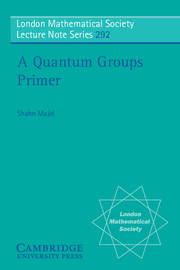Book contents
- Frontmatter
- Contents
- Preface
- 1 Coalgebras, bialgebras and Hopf algebras. Uq(b+)
- 2 Dual pairing. SLq(2). Actions
- 3 Coactions. Quantum plane A2q
- 4 Automorphism quantum groups
- 5 Quasitriangular structures
- 6 Roots of unity. uq(sl2)
- 7 q-Binomials
- 8 Quantum double. Dual-quasitriangular structures
- 9 Braided categories
- 10 (Co)module categories. Crossed modules
- 11 q-Hecke algebras
- 12 Rigid objects. Dual representations. Quantum dimension
- 13 Knot invariants
- 14 Hopf algebras in braided categories. Coaddition on A2q
- 15 Braided differentiation
- 16 Bosonisation. Inhomogeneous quantum groups
- 17 Double bosonisation. Diagrammatic construction of uq(sl2)
- 18 The braided group uq(n+). Construction of uq(g)
- 19 q-Serre relations
- 20 R-matrix methods
- 21 Group, algebra, Hopf algebra factorisations. Bicrossproducts
- 22 Lie bialgebras. Lie splittings. Iwasawa decomposition
- 23 Poisson geometry. Noncommutative bundles. q-Sphere
- 24 Connections. q-Monopole. Nonuniversal differentials
- Problems
- Bibliography
- Index
18 - The braided group uq(n+). Construction of uq(g)
Published online by Cambridge University Press: 18 January 2010
- Frontmatter
- Contents
- Preface
- 1 Coalgebras, bialgebras and Hopf algebras. Uq(b+)
- 2 Dual pairing. SLq(2). Actions
- 3 Coactions. Quantum plane A2q
- 4 Automorphism quantum groups
- 5 Quasitriangular structures
- 6 Roots of unity. uq(sl2)
- 7 q-Binomials
- 8 Quantum double. Dual-quasitriangular structures
- 9 Braided categories
- 10 (Co)module categories. Crossed modules
- 11 q-Hecke algebras
- 12 Rigid objects. Dual representations. Quantum dimension
- 13 Knot invariants
- 14 Hopf algebras in braided categories. Coaddition on A2q
- 15 Braided differentiation
- 16 Bosonisation. Inhomogeneous quantum groups
- 17 Double bosonisation. Diagrammatic construction of uq(sl2)
- 18 The braided group uq(n+). Construction of uq(g)
- 19 q-Serre relations
- 20 R-matrix methods
- 21 Group, algebra, Hopf algebra factorisations. Bicrossproducts
- 22 Lie bialgebras. Lie splittings. Iwasawa decomposition
- 23 Poisson geometry. Noncommutative bundles. q-Sphere
- 24 Connections. q-Monopole. Nonuniversal differentials
- Problems
- Bibliography
- Index
Summary
In this lecture we are finally able to construct uq(g) for general complex semisimple Lie algebras g, as an example of the general doublebosonisation construction. We have already indicated how they may be built up by repeatedly adjoining quantum-braided planes via the double bosonisation – in effect we accumulate all these steps into a single braided group B and define uq(g) = Bf>′⋊H⋉Bop. This is much more useful than simply giving a large number of generators and relations to check: for example it implies by construction a ‘triangular decomposition’ of uq(g).
Before doing this, we will later need one more general result about double bosonisation, which there was not space to include in the last lecture.
Proposition 18.1
Let B be a braided group in a braided category C and dually paired with B′. Assume that B, B′ have invertible antipode. Then the category B′CB has a canonical object (V, ▹, ◃) given by
1. V = B as an object of C.
2. ◃ the right adjoint action of B on B as shown in the upper box in Figure 18.1.
3. ▹ the right coregular action of B′on B made into a left action, as shown in the lower box in Figure 18.1.
The product of B becomes a morphism in B′CB
Proof This is proven by diagrams as shown in Figure 18.1. We show that ▹, ◃ obey the crossed bimodule compatibility property of B′CB, using the elementary properties of braided groups from Lectures 14 and 15.
- Type
- Chapter
- Information
- A Quantum Groups Primer , pp. 113 - 119Publisher: Cambridge University PressPrint publication year: 2002



